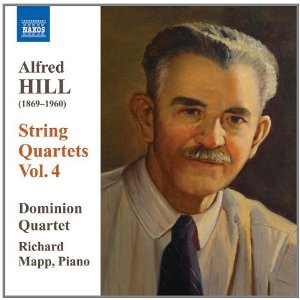 |
 |
|


alternatively
CD: MDT
AmazonUK
AmazonUS
Sound
Samples & Downloads |
Alfred HILL (1869-1960)
String Quartet No. 10 in E-major (1935) [20:18]
String Quartet No. 11 (1935) [19:38]
Life Quintet for Piano and Strings with Eight Voices in
the Finale (1912) [39:26]
 The Dominion Quartet (Yury Gezentsvey, Rosemary Harris (violins);
Donald Maurice (viola); David Chickering (cello)); Richard Mapp
(piano); (Bryony Williams, Amelia Berry (sopranos); Linden Loader,
Annabelle Cheetham (mezzos); Richard Greager, Chris Berentson (tenors);
Daniel O’Connor, Keith Small, (basses))/Mark Dorrell (conductor)
The Dominion Quartet (Yury Gezentsvey, Rosemary Harris (violins);
Donald Maurice (viola); David Chickering (cello)); Richard Mapp
(piano); (Bryony Williams, Amelia Berry (sopranos); Linden Loader,
Annabelle Cheetham (mezzos); Richard Greager, Chris Berentson (tenors);
Daniel O’Connor, Keith Small, (basses))/Mark Dorrell (conductor)
rec. 15-16 December 2009, Adam Concert Room, Victoria University
of Wellington (Quartets) and 30-31 May 2011, Ilott Theatre, Wellington
Town Hall (Quintet) DDD
 NAXOS 8.572844 [79:40]
NAXOS 8.572844 [79:40]
|
|
|
Alfred Hill was the first Australasian composer of prominence
and during his long career produced hundreds of compositions
as well as hundreds more arrangements, orchestrations and re-workings
of earlier works. His seventeen string quartets are the core
of his output and all of them are in process of being recorded
by the estimable Dominion Quartet. This is volume 4 in the series.
Hill studied in Leipzig in the 1890’s and his compositional
style is frequently described as 19th century German Romantic.
Actually his quartets and other works demonstrate a variety
of influences, although a certain Schumann/Brahms foundation
is evident. The reader is directed to Rob Barnett’s excellent
article elsewhere on this site (see
article) for more information.
The Quartet No. 10 is built entirely from a four-note motif.
Hill’s skill at thematic development and his experience as a
quartet player are amply demonstrated. The first movement has
a somewhat Elgarian wistfulness, occasionally descending to
sentimentality, with the middle movements showing a contrapuntal
skill not often credited to Hill and the last movement having
some truly eloquent pages. The Quartet No. 11 is impressionistic
in idiom and altogether more serious than its predecessor, although
the two works were written in the same year. It has been recorded
more than once before and is probably the best known of the
quartets. The harmony is reminiscent of Delius, but the use
of D-major tonality follows older procedures, though in an original
way. The slow movement makes excellent use of the viola (no
surprise to those who know the composer’s fine Viola Concerto)
and has a haunting ending. The third movement is somewhat folkish,
but again pays tribute to Delius at the end.
The genesis and history of Hill’s Piano Quintet would tend to
distract from its musical qualities. The final chorale of the
choral last movement originated as the last section of a large-scale
Exhibition Ode for the opening of the Christchurch Exhibition
in 1906. The three instrumental movements were written in 1912
and combined with a setting of a new text including a reduced
version of the 1906 chorale. In 1933 some of the music, with
different words, was used for an Empire Day broadcast in Sydney
in the form of the cantata From the Southern Seas.
Finally, the entire Quintet was modified as the Symphony No.2
(Joy of Life) during the Second World War. This was
recorded by the South Australian Symphony Orchestra conducted
by Patrick Thomas on a Festival LP SFC800/18. In addition, the
Quintet has a program. As a chamber work it is very impressive,
with a solemn introduction followed by an exuberant and somewhat
polyphonic main section in the first movement (Life is Vigorous
in Hill’s program). The slow movement is an imaginative, if
slightly over-doleful, funeral march with a central section
(not really a trio) that is quite moving (Life is sorrowful,
but not without hope). There is an energetic scherzo (Life
as play), well-played by the Dominion Quartet and Richard
Mapp, and the choral Gloria in Excelsis Deo. As vocal
chamber music the finale is quite enjoyable, if not a musically
convincing conclusion to the preceding three movements, but
the final chorale doesn’t fit with anything that has gone before
it.
The Dominion Quartet was formed in 2006 to record works of New
Zealand composers (Hill lived in both Australia and New Zealand).
They have a lovely sound and a good ensemble, although occasionally
show a tendency towards slower speeds than necessary. The recorded
sound for the two quartets is rich, although a little too closely
miked. The venue for the Quintet provides more problems with
a sharp, brittle effect that is a definite distraction. I have
not heard the first three volumes in this series (see reviews
for volumes 1,
2,
3),
but if only on the basis of this disc, I can highly recommend
the series, both for committed playing and as first documentation
of an important part of the quartet repertoire.
William Kreindler
See also review by Byzantion
|
|

